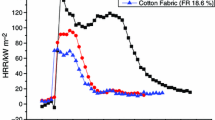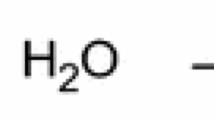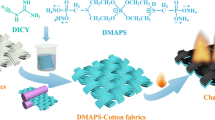Abstract
A novel flame-retardant agent, nitrogen- and phosphorus-containing polysiloxane [(IB-co-N-MDPA)PDMS] was synthesized, and it was employed on cotton fabrics. Cone calorimeter testing showed that the treated cotton fabric with (IB-co-N-MDPA)PDMS became less flammable with longer time to ignition and lower value of HRR, THR, EHC and mass loss. Thermogravimetric analysis demonstrated that (IB-co-N-MDPA)PDMS improved the thermal and thermo-oxidative stability of cotton fabric with fewer flammable volatiles, and more char is produced during combustion. Scanning electron microscopy showed that the surface of treated cotton fabric after combustion was covered by a compact char layer which indicated that (IB-co-N-MDPA)PDMS favored the formation of char as evidenced by the FTIR of residues. Furthermore, EDS analysis results demonstrated that the concurrent presence of Si and P in flame retardant effectively enhance the flame retardancy of cotton fabric with the remarkable amount of Si and P elements that were still present on the surface of fibers after combustion.













Similar content being viewed by others
References
White LA. Preparation and thermal analysis of cotton-clay nanocomposites. J Appl Polym Sci. 2004;92:2125–31.
Yang CQ, He Q. Applications of micro-scale combustion calorimetry to the studies of cotton and nylon fabrics treated with organophosphorus flame retardants. J Anal Appl Pyrolysis. 2011;91:125–33.
Horrocks AR. Flame retardant challenges for textiles and fibres: new chemistry versus innovatory solutions. Polym Degrad Stab. 2011;96:377–92.
Mostashari SM, Mostashari SZ. Combustion pathway of cotton fabrics treated by ammonium sulfate as a flame-retardant studied by TG. J Therm Ana Calorim. 2008;91:437–41.
Wakelyn PJ. New and potential textile flammability regulations and test methods within the USA. In: Hull TR, Kandola BK, editors. Fire retardancy of polymers: new strategies and mechanisms. RSC Publishing; 2009. p. 266–93.
Lessan F, Montazer M, Moghadam MB. A novel durable flame-retardant cotton fabric using sodium hypophosphite, nano TiO2 and maleic acid. Thermochim Acta. 2011;520:48–54.
Siow HE, Laurendeau NA. Flame inhibition activity of phosphorus-containing compounds using laser-induced fluorescence measurements of hydroxyl. Combust Flame. 2004;136:16–24.
Rahman F, Langford KH, Scrimshaw MD, Lester JN. Polybrominated diphenyl ether (PBDE) flame retardants. Sci Total Environ. 2001;275:1–17.
Legler J, Brouwer A. Are brominated flame retardants endocrine disruptors? Environ Int. 2003;29:879–85.
Weil ED, Levchik SV. Flame retardants in commercial use or development for textiles. J Fire Sci. 2008;26:243–81.
Xie K, Gao A, Zhang Y. Flame retardant finishing of cotton fabric based on synergistic compounds containing boron and nitrogen. Carbohydr Polym. 2013;98:706–10.
Alongi J, Ciobanu M, Malucelli G. Novel flame retardant finishing systems for cotton fabrics based on phosphorus-containing compounds and silica derived from sol-gel processes. Carbohydr Polym. 2011;85:599–608.
Alongi J, Milnes J, Malucelli G, Bourbigot S, Kandola B. Thermal degradation of DNA-treated cotton fabrics under different heating conditions. J Anal Appl Pyrolysis. 2014;108:212–21.
Abou-Okeil A, El-Sawy SM, Abdel-Mohdy FA. Flame retardant cotton fabrics treated with organophosphorus polymer. Carbohydr Polym. 2013;92:2293–8.
Duquesne S, Lefebvre J, Seeley G, Camino G, Delobel R, Bras ML. Vinyl acetate/butyl acrylate copolymers-Part 2: fire retardancy using phosphorus-containing additives and monomers. Polym Degrad Stab. 2004;85:883–92.
Gaan S, Sun G, Hutches K, Engelhard MH. Effect of nitrogen additives on flame retardant action of tributyl phosphate: phosphorus-nitrogen synergism. Polym Degrad Stab. 2008;93:99–108.
Chang S, Slopek RP, Condon B, Grunlan JC. Surface coating for flame-retardant behavior of cotton fabric using a continuous layer-by-layer process. Ind Eng Chem Res. 2014;53:3805–12.
Mohamed AL, El-Sheikh MA, Waly AI. Enhancement of flame retardancy and water repellency properties of cotton fabrics using silanol based nano composites. Carbohydr Polym. 2014;102:727–37.
Alongi J, Malucelli G. Cotton fabrics treated with novel oxidic phases acting as effective smoke suppressants. Carbohydr Polym. 2012;90:251–60.
Yang S, Lv G, Liu Y, Wang Q. Synergism of polysiloxane and zinc borate flame retardant polycarbonate. Polym Degrad Stab. 2013;98:2795–800.
Yuan DD, Yin HQ, Cai XF. Effect of a novel flame retardant containing silicon and nitrogen on the thermal stability and flame retardancy of polycarbonate. J Therm Ana Calorim. 2013;111:1531–7.
Zhou TC, He XM, Guo C, Yu J, Lu DL, Yang Q. Synthesis of a novel flame retardant phosphorus/nitrogen/siloxane and its application on cotton fabrics. Text Res J. 2015;85:701–8.
Yuan DD, Yin HQ, Cai XF. Synergistic effects between silicon-containing flame retardant and potassium-4-(phenylsulfonyl)benzenesulfonate (KSS) on flame retardancy and thermal degradation of PC. J Therm Anal Calorim. 2013;114:19–25.
Wang N, Wu YH, Mi L, Zhang J, Li XR, Fang QH. The influence of silicone shell on double-layered microcapsules in intumescent flame-retardant natural rubber composites. J Therm Anal Calorim. 2014;118:349–57.
Vasiljevic J, Hadzic S, Jerman I, et al. Study of flame-retardant finishing of cellulose fibres: organiceinorganic hybrid versus conventional organophosphonate. Polym Degrad Stab. 2013;98:2602–8.
Lecoeur E, Vorman I, Bourbigot S, et al. Optimization of monoguanidine dihydrogen phosp- hate and amino propylethoxysilane based flame retardant formulations for cotton. Polym Degrad Stab. 2006;91:1909–14.
Nazare S, Kandola BK, Horrocks AR. Smoke, CO, and CO2 measurements and evaluation using different fire testing techniques for flame retardant unsaturated polyester resin formulations. J Fire Sci. 2008;26:215–42.
Alongi J, Camino G, Malucelli G. Heating rate effect on char yield from cotton, poly(ethylene terephthalate) and blend fabrics. Carbohydr Polym. 2013;92:1327–34.
Wang CS, Shieh JY. Synthesis and properties of epoxy resins containing bis(3-hydroxyphenyl) phenyl phosphate. Eur Polym J. 2000;36:443–52.
Chen DQ, Wang YZ, Hu XP. Flame-retardant and anti-dripping effects of a novel char-formingflame retardant for the treatment of poly (ethylene terephthalate) fabrics. Polym Degrad Stab. 2005;88:349–56.
Acknowledgements
This work was supported by the Opening Project of Key Laboratory of Clean Dyeing and Finishing Technology of Zhejiang Province, Project Number: 1507. This work was also supported by and The Project Sponsored by the Scientific Research Foundation for the Returned Overseas Chinese Scholars, State Education Ministry.
Author information
Authors and Affiliations
Corresponding author
Rights and permissions
About this article
Cite this article
Dong, C., Lu, Z., Zhang, F. et al. Combustion behaviors of cotton fabrics treated by a novel nitrogen- and phosphorus-containing polysiloxane flame retardant. J Therm Anal Calorim 123, 535–544 (2016). https://doi.org/10.1007/s10973-015-4914-4
Received:
Accepted:
Published:
Issue Date:
DOI: https://doi.org/10.1007/s10973-015-4914-4




